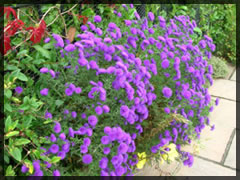A Very English Class Of Drought
Hints for the gardener on surviving the hosepipe ban
Whatever your views on droughts, global warming and hosepipe bans, thus far it has been a peculiarly English class of a drought. April had us gathering animals two by two and reaching for a D.I.Y. manual on ark building, that was out of print Millennia past. The last few days have had us slowly basking or cooking under a blazing sun and as I write my smart phone weather app predicts rain for the next three days.
However, it is good growing weather for everything, including weeds. The best possible option would be rain between 1 am and 5am, then a good mid-twenties sunny day and I’m sure we’d all be happy.
Unfortunately and tending towards cynicism myself, the Jubilee, Ascot, Olympics and Wimbledon appear an open invitation for a grand old traditional British summer. Over the past few years, late September and October have seen better weather, the mellow magic of autumn and a tolerable heat that dehydrates neither man, nor plant, but gently promises grand abundance and good harvests.

The hosepipe ban itself is something of a farce, with so many provisions and exclusions that one could drive the proverbial coach and horses through it. For instance, a pond with fish can be filled by hose, a patio deemed a risk factor with moss, etc. can be pressure cleaned & gardeners can water anything newly planted for around six weeks with a hose. Then, of course the car cleaners in supermarket car parks are working away as normal, as are all manner of other water fuelled trades.
Should, indeed, a drought prevail, then there are a number of hints and tips to aid the gardener. In WW2, gardeners would place newspaper at the bottom of pots, fill with compost and plant up, the newspaper held water and rotted down to create free feed. Nowadays you can buy water retention crystals that go in like granulated sugar, mix with the compost, soak for a quarter of an hour and it swells like wallpaper paste, to hold around 400 times its own weight in a jelly which doesn’t drown roots. Mulches of chipped bark, shingle, membrane, or even grass cuttings are useful spread around the stems of plants, as all inhibit evaporation and keep the soil from drying out. These days, the bags of compost commonly available will quickly dry to almost dust, although moisture retentive compost in now available at an added premium.

With regard to planters and troughs; a pelleted slo release fertilizer mixed into the compost will feed the plants for up to six months, as it slowly dissolves each time it gets damp. Ordinary liquid and powder fertilizers are washed out after about a month. A top dressing of 10mm shingle to all containers will inhibit evaporation and reflect light, giving a professional finish.
Choosing seasonal bedding and colour is very much like Russian roulette, as one tries to second guess the upcoming season and plants that are suited to the prevailing conditions. My personal preference is the darker coloured Pelargoniums over the traditional Geraniums; an added bonus is that both are likely to overwinter in cities and cut back in the spring flourish the following year. Another favourite is Osteospermium, which come in a variety of bright colours, some with spoonback petals and again they often overwinter with few problems and are an unusual and rewarding choice.
Mike O’Brien; Townhouse Gardens.
http://www.townhouse-gardens.co.uk
June 1, 2012